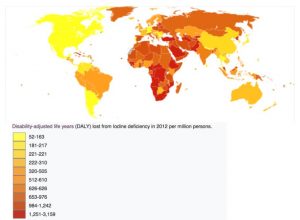Chapter 11: Micronutrients in Metabolism
11.9 Iodine
University of Hawai‘i at Mānoa Food Science and Human Nutrition Program
Recall the discovery of iodine and its use as a means of preventing goiter, a gross enlargement of the thyroid gland in the neck. Iodine is essential for the synthesis of thyroid hormone, which regulates basal metabolism, growth, and development. Low iodine levels and consequently hypothyroidism has many signs and symptoms including fatigue, sensitivity to cold, constipation, weight gain, depression, and dry, itchy skin and paleness. The development of goiter may often be the most visible sign of chronic iodine deficiency, but the consequences of low levels of thyroid hormone can be severe during infancy, childhood, and adolescence as it affects all stages of growth and development. Thyroid hormone plays a major role in brain development and growth and fetuses and infants with severe iodine deficiency develop a condition known as cretinism, in which physical and neurological impairment can be severe. The World Health Organization (WHO) estimates iodine deficiency affects over two billion people worldwide and it is the number-one cause of preventable brain damage worldwide.[1]


Dietary Reference Intakes for Iodine
Table 11.91 Dietary Reference Intakes for Iodine[2]
| Age Group | RDA Males and Females mcg/day | UL |
| Infants (0–6 months) | 110* | Not possible to determine |
| Infants (7–12 months) | 130* | Not possible to determine |
| Children (1–3 years) | 90 | 200 |
| Children (4–8 years) | 90 | 300 |
| Children (9–13 years) | 120 | 600 |
| Adolescents (14–18 years) | 150 | 900 |
| Adults (> 19 years) | 150 | 1,100 |
| Pregnancy | 220 | Same as non-pregnant |
| Lactation | 290 | Same as non-lactating |
| *denotes Adequate Intake | ||
Dietary Sources of Iodine
The mineral content of foods is greatly affected by the soil from which it grew, and thus geographic location is the primary determinant of the mineral content of foods. For instance, iodine comes mostly from seawater so the greater the distance from the sea the lesser the iodine content in the soil. Because of this high variability in iodine content and the importance of iodine in brain development, many countries add iodine to table salt. Consumption of 1/2 teaspoon of iodized salt meets the RDA for iodine.
Table 11.92 Iodine Content of Various Foods[3]
| Food | Serving | Iodine (mcg) | Percent Daily Value |
| Seaweed | 1 g. | 16 to 2,984 | 11 to 1,989 |
| Cod fish | 3 oz. | 99 | 66 |
| Yogurt, low fat | 8 oz. | 75 | 50 |
| Iodized salt | 1.5 g. | 71 | 47 |
| Milk, reduced fat | 8 oz. | 56 | 37 |
| Ice cream, chocolate | ½ c. | 30 | 20 |
| Egg | 1 large | 24 | 16 |
| Tuna, canned | 3 oz. | 17 | 11 |
| Prunes, dried | 5 prunes | 13 | 9 |
| Banana | 1 medium | 3 | 2 |
- World Health Organization. “Iodine Status Worldwide.” Accessed October 2, 2011. http://whqlibdoc.who.int/publications/2004/9241592001.pdf. ↵
- Dietary Fact Sheet for Health Professionals: Iodine. National Institute of Health, Office of Dietary Supplements. https://ods.od.nih.gov/factsheets/Iodine-HealthProfessional/. Updated April 28, 2022. Accessed August 2, 2023. ↵
- Ibid. ↵
Basal metabolism refers to the calories you burn while at rest. See basal metabolic rate.
Hypothyroidism occurs when insufficient amounts of thyroid hormone are produced. Signs and symptoms including fatigue, sensitivity to cold, constipation, weight gain, depression, dry skin, and paleness.
Infancy is the earliest part of childhood. It is the period from birth through age one.
A condition that can be caused by iodine deficiency during fetal development or infancy. Lack of thyroid hormone during brain development can lead to severe physical and neurological impairment.

